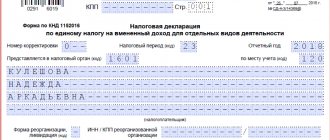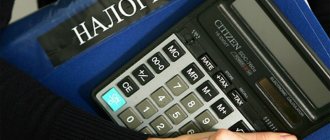UTII has been canceled from 01/01/2021!
| Year of application | Size | Base |
| from 2021 | Canceled | part 8 art. 5 97-FZ dated June 29, 2012 |
| 2020 | 2,005 | Order of the Ministry of Economic Development of Russia dated December 10, 2019 No. 793 |
| 2019 | 1,915 | Order of the Ministry of Economic Development of Russia dated October 30, 2018 No. 595 |
| 2018 | 1,868 | Order of the Ministry of Economic Development of Russia dated October 30, 2017 No. 579 |
| 2017 | 1,798 | Order of the Ministry of Economic Development of Russia dated November 3, 2016 No. 698 |
| 2016 | 1,798 | |
| 2015 | 1,798 | |
| 2014 | 1,672 | |
| 2013 | 1,569 | |
| 2012 | 1,4942 | |
| 2011 | 1,372 | |
| 2010 | 1,295 | |
| 2009 | 1,148 | |
| 2008 | 1,081 | |
| 2007 | 1,096 | |
| 2006 | 1,132 | |
| 2005 | 1,104 | |
| 2004 | 1,133 | |
| 2003 | 1 |
The table below shows how the value of the K1 coefficient has changed since 2003 based on the relevant orders of the Ministry of Economy and Development of the Russian Federation.
The deflator coefficient K1, used for UTII, establishes the corrective values of taxation under the UTII system taking into account the amount of inflation and refers to variable indicators at the federal level, the size of which is determined annually and approved by the relevant order of the Ministry of Economic Development of the Russian Federation.
Coefficient K1
K1 is a deflator coefficient. It is used to bring imputed income to the level of consumer prices for goods (works, services) of the previous year. In other words, to take into account the impact of inflation (paragraph 5 of Article 346.27 of the Tax Code of the Russian Federation).
The value of K1 for the next calendar year is set by the Ministry of Economic Development of Russia. The deflator coefficient is published in Rossiyskaya Gazeta no later than November 20 of the previous year (clause 2 of the order of the Government of the Russian Federation of December 25, 2002 No. 1834-r).
For 2021, K1 is set at 1.798.
K2 coefficient
K2 – correction factor. With its help, various factors that affect the basic profitability of various types of business activities are adjusted. For example, the range of goods, seasonality, operating hours, amount of income, etc. This is stated in paragraph 6 of Article 346.27 of the Tax Code of the Russian Federation.
Use the value of the K2 coefficient in the calculation of UTII. When preparing a tax return, reflect it on line 090 of section 2 of the form approved by order of the Federal Tax Service of Russia dated January 23, 2012 No. ММВ-7-3/13.
additional information
An interesting feature of UTII is its ability to simultaneously replace several types of duties from the general taxation system. For example, this duty can replace income tax, value added duty (exports are not taken into account), as well as property tax. An interesting feature of the tax is that when calculating the amount, the average indicators for a particular type of activity are taken into account, and are not linked to the actual income of the taxpayer.
If we talk about the rate, now it is equal to 15% of the total amount. It is important to note that municipal authorities are allowed to reduce the rate from 15% to 7.5%, that is, by half. When reducing the rate, the category to which the taxpayer belongs and the type of his main activity must be taken into account.
Who approves K2
The value of K2 is determined by the authorities of municipalities - districts, city districts, as well as legislators of federal cities, for example St. Petersburg. To determine exactly what correction factor to use, consult your local regulations.
Which municipality should you choose if the organization operates in several regions at once? For example, it transports goods throughout Russia. In this case, determine the value of K2 on the basis of the regulatory documents of the municipality in which the company was registered for tax purposes as a payer of UTII. This follows from the provisions of paragraph 2 of Article 346.28 of the Tax Code of the Russian Federation and is confirmed in the letter of the Ministry of Finance of Russia dated October 25, 2010 No. 03-11-11/282.
Conditions of use
This taxation system cannot be applied to all individual entrepreneurs, but only to those engaged in certain types of activities. Thus, UTII is available to those who are engaged, for example, in retail or catering. The full list of activities to which UTII is available is indicated in the Tax Code.
In addition, other legal conditions must be met:
●
such an individual entrepreneur should employ no more than 100 people;
●
this tax regime must be valid in the territory of the individual entrepreneur;
●
the activities of an individual entrepreneur are not activities within the framework of a simple partnership or trust management agreement;
●
Individual entrepreneurs do not lease gas stations and gas stations.
UTII will not be used in Moscow!
When the approved K2 comes into force
The following table will help you understand from what point to use K2, approved by local authorities.
| Which K2 was established by local authorities | Conditions in the regulatory document that approved K2 and the moment when it was published | From when to apply the coefficient? | Base |
| K2 has been reduced from a previously approved value or has been approved for the first time to be less than 1 | It clearly states when the changes will take effect. The moment of publication does not matter | From the moment of publication, tax can be calculated taking into account the new K2. Moreover, the recalculation can be done from the date established in the regulatory document. Even if it precedes publication | Clause 3 of Article 5 of the Tax Code of the Russian Federation |
| The date when the changes take effect is not specified. The moment of publication is not important | One month after the publication of the amending document, but not earlier than the next tax period - quarter | Paragraph 1 of paragraph 1 and paragraph 3 of Article 5 of the Tax Code of the Russian Federation | |
| K2 has been increased compared to the previously approved value | The regulatory document was published on December 1 of the current year or later until the end of this month | From January 1 of the year following the current one. For example, if a document was published on December 15, 2014, you are required to apply the new K2 only from January 1, 2021 | Clause 1 of Article 5 and Clause 7 of Article 346.29 of the Tax Code of the Russian Federation |
| The regulatory document was published before December 1 of the current year | One month after the publication of the amending document, but not earlier than the next tax period - quarter | Clause 1 of Article 5 of the Tax Code of the Russian Federation |
How to calculate UTII when K2 is not installed
It happens that there is no local regulatory document establishing K2. Or it exists, but by the beginning of this year it had not come into force. What to do in such situations?
In the first case, calculate UTII based on the basic profitability, the amount of which is given in paragraph 3 of Article 346.29 of the Tax Code of the Russian Federation (determination of the Supreme Arbitration Court of the Russian Federation dated May 29, 2009 No. VAS-3703/09).
In the second case, use the value of the adjustment factor that was in effect last year. Such rules are established by paragraph 7 of Article 346.29 and paragraph 1 of Article 346.26 of the Tax Code of the Russian Federation.
What else is changing according to UTII since 2018?
From January 1, 2021, consumer cooperation organizations whose average number of employees over the past year exceeded 100 people can apply UTII until December 31, 2021. Previously, the deadline was December 31, 2021. Basis: Clause 4 art. 3 of the Law of October 2, 2012 No. 161-FZ, Law of October 30, 2021 No. 300-FZ
The validity of the norm of the Tax Code of the Russian Federation, allowing some consumer cooperation organizations to apply UTII with a staff of more than 100 people, ended on December 31, 2021. According to this norm, organizations and individual entrepreneurs whose average number of employees for the previous calendar year exceeded 100 people were not entitled to pay UTII. However, this restriction did not apply to organizations whose authorized capital consists entirely of contributions from public organizations of disabled people, if the average number of disabled people among their employees is at least 50%, and their share in the wage fund is at least 25%, to consumer cooperation organizations operating in accordance with Law No. 3085-1, as well as business companies whose sole founders are consumer societies and their unions (paragraph 2, sub-clause 1, clause 2.2 of Article 346.26 of the Tax Code).
Sub-coefficients
The value of the K2 coefficient may consist of individual sub-coefficients. Local authorities have the right to provide for such division. The basis is subparagraph 3 of paragraph 3 of Article 346.26 of the Tax Code of the Russian Federation.
The value of K2, which consists of subcoefficients, can be determined by multiplying the values of these components. Round the result obtained according to the rules of arithmetic to the third decimal place. As a result, a single value can range from 0.005 to 1.0 inclusive. This is established by paragraphs 6, 7 and 11 of Article 346.29 of the Tax Code of the Russian Federation.
Situation: how to calculate the K2 coefficient when selling goods of different product groups? Local law establishes different values for the K2 subcoefficients for each group.
The answer to this question depends on whether the organization can document the amount of sales revenue for each group of goods.
There is data confirming the amount of revenue for each group of products. Determine K2 based on the share of retail turnover of each group of goods in their total volume. This must be done in two stages.
First, calculate the final sub-coefficient K2, taking into account the range of goods. To do this, use the formula:
| The final sub-coefficient K2, taking into account the range of goods | = | Sub-coefficient K2, taking into account the range of goods, for the first group of goods | × | Revenue from sales of the first group of goods ____________________ | × | Sub-coefficient K2, taking into account the range of goods, for the second group of goods | × | Revenue from sales of the second group of goods ____________________ |
| Revenue from sales of both groups of goods | Revenue from sales of both groups of goods |
Then determine the total value of the K2 coefficient using the formula:
| K2 coefficient | = | The final sub-coefficient K2, taking into account the range of goods | × | Sub-coefficients K2, taking into account other factors (seasonality, operating hours, location, etc.) |
The total value of the coefficient K2 cannot be less than 0.005 and more than 1.0 inclusive (clause 7 of article 346.29 of the Tax Code of the Russian Federation).
There is no data confirming the amount of revenue for each product group. When calculating UTII, use the highest value of the K2 coefficient.
This procedure is based on the provisions of paragraph 2 of paragraph 6 of Article 346.29 of the Tax Code of the Russian Federation and is recommended in the letter of the Ministry of Finance of Russia dated April 1, 2013 No. 03-11-11/125.
An example of calculating the K2 coefficient when selling goods of various product groups. For each group of goods, different values of the K2 subcoefficients are established. The organization determines the final sub-coefficient K2, which takes into account the range of goods, as a weighted average
The organization conducts retail trade (sales of household appliances and office supplies) through a store with a sales area of less than 150 sq. m. m. From this activity the organization pays UTII. In the municipality where the organization operates, to determine the value of the K2 coefficient, subcoefficients are used that take into account the assortment and salary level in the organization.
The values of subcoefficients taking into account the range of goods are set in the following sizes:
- 0.53 – in relation to household appliances;
- 0.4 – in relation to office supplies.
Taking into account the current average salary, the organization applies a subcoefficient that takes into account the salary level in the organization in the amount of 0.7.
In the third quarter, revenue from sales of both groups of goods amounted to 1,000,000 rubles. At the same time, household appliances were sold for 900,000 rubles, office supplies – for 100,000 rubles.
The share of revenue from sales of goods of various groups at the end of the third quarter was:
- 0.9 (900,000 rubles: 1,000,000 rubles) – in relation to household appliances;
- 0.1 (RUB 100,000: RUB 1,000,000) – in relation to office supplies.
The organization calculated the final sub-coefficient K2, taking into account the range of goods, as follows: 0.53 × 0.9 + 0.4 × 0.1 = 0.517.
The value of the general coefficient K2, determined on the basis of subcoefficients that take into account the range of goods and salary level, is equal to 0.3619 (0.517 × 0.7).
Increasing UTII from 2021: calculation example
Let's try using examples to calculate UTII from 2021 taking into account the new coefficient (Order of the Ministry of Economic Development of Russia dated October 30, 2021 No. 579) and compare the indicators with 2021. So, the general formula for calculating UTII in 2021 remains the same:
| UTII for the quarter = Tax base (imputed income) for the quarter X Tax rate |
Let us give examples of calculations adjusted for K1.
An example of calculating UTII in 2021
Tsvetochek LLC is engaged in retail trade through its own store with a sales area of 80 sq. m. m. In the city where trade is carried out, the use of UTII is allowed. The tax rate for retail is 15%. Alpha LLC conducted imputed activities in January, February and March. The calculation will be based on the following indicators:
- in 2021, the new value of the deflator coefficient K1 is 1.868;
- The regional authorities set the value of the correction coefficient K2 at 0.7.
- the basic profitability for retail trade in the presence of trading floors is 1800 rubles/sq.m. m.
Imputed income for February–March 2021 (that is, for the 1st quarter) will be:
564,883.20 rubles. = 1800 rub./sq. m × (80 sq. m + 80 sq. m + 80 sq. m) × 0.7 × 1,868.
UTII for the first quarter of 2021 with the new value of the K1 coefficient will be:
RUB 84,732.48 = RUB 571,838 × 15%
Comparison of calculation with 2021
If the project to increase the coefficients for “imputation” had not been adopted and in 2021 the K1 coefficient had remained at the same level - 1.798, then, under the same conditions, the amount of UTII payable for the 1st quarter of 2017 would have been less. In this case, the basic profitability indicator would be equal to 543,715 rubles. = 1800 rub./sq. m × (80 sq. m + 80 sq. m + 80 sq. m) × 0.7 × 1.798 . The amount of tax payable would be RUB 81,557 = RUB 543,715. × 15%
But the new coefficient for UTII was approved. Therefore, with similar indicators, the amount of UTII for the 1st quarter of 2021 increased by 3175.48 rubles. (84,732.48 – 81,557 rubles). In percentage terms, the increase in 2021 will be 3.4 percent.
At the same time, we note that individual entrepreneurs have the right to reduce UTII by the amount of insurance premiums. For more information about this, see “Insurance contributions of individual entrepreneurs on UTII”.



